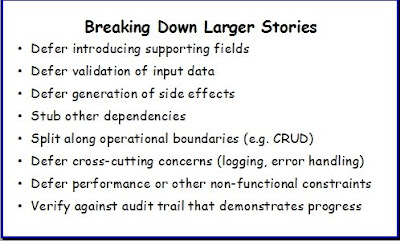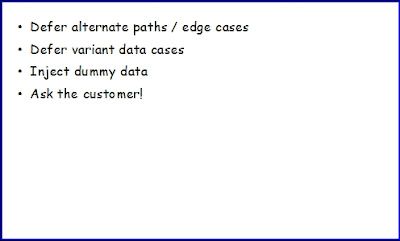

Source: Jeff Langr, Tim Ottinger; also, Cohn, Michael. Agile Estimating and Planning.
One ideal for agile development would be to be able to deliver a "done done" story every day. We get a lot of resistance on this thought, and we push right back. Our goal is not to insist on the ideal, but instead to get you to move toward that goal, and not to defend stories that we think are too large. "Too large?" There's no consensus. Anything taking over a half iteration undoubtedly should be scrutinized.
One way to deliver stories more frequently is collaborate a bit more. Instead of one developer working a large story alone (sadly common), consider adding another developer or two or three. If they can help deliver the story sooner without inordinate overhead costs (including coordination efforts to avoid stepping on each other's toes), go for it.
The other route is to split stories. Breaking down larger stories is an often challenging proposition, but the more you do it, the easier it gets. Next time you have a large story, step through the list on the card.
The most challenging stories are "iceberg" stories. These are stories where the customer sees only a small impact, but the algorithmic or data complexity required to implement the story is large.
Sometimes a split isn't worth it. For example, you look to consider an alternate case as a separate story, but the developer says, "well, it's only going to take me ten minutes to implement that."
A key thing to think about when looking to split stories is the tests.
- Defer alternate paths / edge cases - If anything, thinking about how to split stories around alternate cases will force you to make sure you've captured all of them!
- Defer introducing supporting fields - If the story involves user input of good-sized chunks of data, support a few key and/or significant fields and introduce the remainder later.
- Defer validation of input data - Demonstrate that you can capture the information; add the ability to prevent the system from accepting invalid data later.
- Defer generation of side effects - For example, creating a downstream feed when the user updates information.
- Stub other dependencies - "Fake it until you make it."
- Split along operational boundaries (e.g. CRUD) - This is directly from Cohn's book. Note that you don't necessarily have to have "C" (Create) done before you implement "U" (Update).
- Defer cross-cutting concerns (logging, error handling) - This generates an interesting challenge around an important point--devising acceptance tests that verify the addition of robustness concerns.
- Defer performance or other non-functional constraints - Sometimes it's possible to bang out an implementation using an overly simplistic algorithm. A similar challenge: How do you devise acceptance criteria for the performance improvement?
- Verify against audit trail that demonstrates progress - I'm not enamored with this one, but sometimes there are no other obvious solutions. Sometimes this will expose more implementation details than you would like. Perhaps these tests can disappear once the entire story gets completed.
- Defer variant data cases - Will it simplify the logic if we don't have to worry about special data cases? Or more complex data variants? For example, it's probably a lot easier to devise a delivery scheduling system that supports only one destination.
- Inject dummy data - In some cases, data availability or volume can be a barrier to full implementation of a story.
- Ask the customer! - You may be pleasantly surprised!
Well, this list isn't necessarily complete, and needs a bit of work. What other story splitting mechanisms have you used successfully?
As for deferring alternate paths, the number of acceptance tests provides a good first approximation to the number of paths. Just breaking stories down along the lines of each acceptance test is not a bad approach, especially for new teams.
ReplyDeleteNothing takes only 10 minutes. I know when a developer says that they have not yet understood the difference between implemented and really done. What is the big problem with the next split of a story taking only an hour or two anyway?
Steven Gordon
Hi Steven,
ReplyDeleteThanks for the feedback. You're right, nothing ever takes 10 minutes by the time it's done. What I was thinking about when writing this is a very large story--something initially estimated at, say, 10 days. So I'm looking for ways to break it up into a number of smaller chunks, not one tiny chunk and a chunk that's still pretty close to 10 days. In those cases I probably want to consider a different split, unless I can decompose the bulk of the 10 days in some other manner.